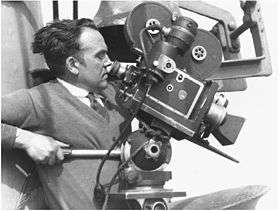Academy Award for Best Cinematography
| Academy Award for Best Cinematography | |
|---|---|
| Country | United States |
| Presented by | Academy of Motion Picture Arts and Sciences (AMPAS) |
| First awarded | 1929 |
| Currently held by |
Emmanuel Lubezki The Revenant (2015) |
| Official website |
oscars |
The Academy Award for Best Cinematography is an Academy Award awarded each year to a cinematographer for work on one particular motion picture.
History

In its first film season, 1927–28, this award (like others such as the acting awards) was not tied to a specific film; all of the work by the nominated cinematographers during the qualifying period was listed after their names. The problem with this system became obvious the first year, since Karl Struss and Charles Rosher were nominated for their work together on Sunrise but three other films shot individually by either Rosher or Struss were also listed as part of the nomination. The second year, 1929, there were no nominations at all, although the Academy has a list of unofficial titles which were under consideration by the Board of Judges. In the third year, 1930, films, not cinematographers, were nominated, and the final award did not show the cinematographer's name.
Finally, for the 1931 awards, the modern system in which individuals are nominated for a single film each was adopted in all profession-related categories. From 1939 to 1967 (with the single exception of 1957), there were also separate awards for color and for black-and-white cinematography. Since then, the only black-and-white film to win is Schindler's List (1993).
Floyd Crosby won the award for Tabu in 1931, which was the last silent film to win in this category. Hal Mohr won the only write-in Academy Award ever, in 1935 for A Midsummer Night's Dream. Mohr was also the first person to win for both black-and-white and color cinematography.
No winners are lost, although some of the earliest nominees (and of the unofficial nominees of 1928–29) are lost, including The Devil Dancer (1927), The Magic Flame (1927), and Four Devils (1928). The Right to Love (1930) is incomplete, and Sadie Thompson (1927) is incomplete and partially reconstructed with stills.
The first nominees to be shot primarily on digital video were The Curious Case of Benjamin Button and Slumdog Millionaire in 2009, with Slumdog Millionaire the first winner.[1] The following year Avatar was the first nominee and winner to be shot entirely on digital video.[2]
No woman has ever been nominated for an award on this category,[3] this makes it the only category in the Academy Award's history where no female contender has ever been nominated.
Superlatives
| Category | Name | Superlative | Year | Notes |
|---|---|---|---|---|
| Most Awards | Leon Shamroy | 4 awards | 1942 | Awards resulted from 18 nominations. |
| Joseph Ruttenberg | 1958 | Awards resulted from 10 nominations. | ||
| Most Nominations | Leon Shamroy | 18 nominations | 1965 | Nominations resulted in 4 awards. |
| Charles B. Lang, Jr. | 1972 | Nominations resulted in 1 award. | ||
| Most Consecutive Awards | Emmanuel Lubezki | 3 consecutive awards | 2013, 2014, 2015 | Awards resulted from 8 nominations. |
| Oldest Winner | Conrad L. Hall | Age 76 | 2002 | Hall died just two months before the awards ceremony. Hall is also the oldest non-posthumous winner, at age 73, in 1999. |
| Oldest Nominee | Asakazu Nakai | Age 84 | 1985 | Nakai shared the nomination with two others. |
| Youngest Winner | Charles B. Lang, Jr. | Age 30 | 1932/1933 |
Lang’s first nomination was at age 28. |
| Youngest Nominee | ||||
| Most Nominations without an Award | George J. Folsey | 13 nominations | ||
| Roger Deakins | One of Deakins’s nominations was shared with Chris Menges. |
Winners and nominees
Winners are listed first in colored row, followed by the other nominees.
1920s
1930s
1940s
1950s
1960s
1970s
1980s
1990s
2000s
2010s
Multiple awards and nominations
See also
- BAFTA Award for Best Cinematography
- Critics’ Choice Movie Award for Best Cinematography
- American Society of Cinematographers Award for Outstanding Achievement in Cinematography in Theatrical Releases
References
- ↑ http://digitalfilms.wordpress.com/2009/01/24/oscar-nominations/
- ↑ http://filmschoolrejects.com/features/oscar-breakdown-best-cinematography.php
- ↑ http://www.indiewire.com/article/8-female-cinematographers-you-should-know-about-20141104/
- ↑ The only competitive Academy Award ever given to an unnominated, write-in candidate.
- ↑ In 1957, the separate Black-and-white and color awards were consolidated.
- ↑ From 1958, there were separate awards for Black and White and for Color again.
External links
- Academy of Motion Picture Arts and Sciences official site
- The Official Academy Awards Database, listing all past nominees and winners